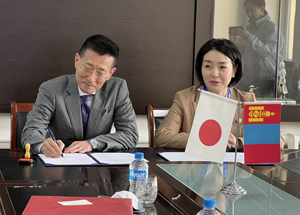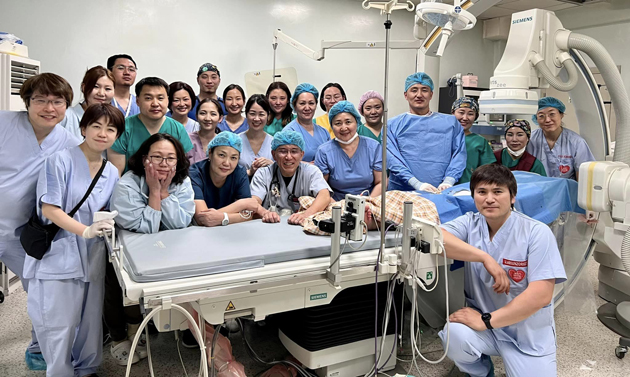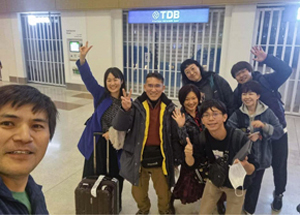cardiac catheter treatment support team 2023.May activity report
6/1/2023
Schedule

Chinggis Khaan International Airport opened 2021 July
5/3 From Narita to Ulanbatar by OM502 (14:40-19:15)
5/4 Echocardiographic examination (82) Afterwards, 2 cases of catheterization
5/5 Catheter treatment followed by conference
5/6 same as a previous day
5/7 From Ulanbatar to Narita by OM501 (7:45 13:40)
Result
This time total
Echocardiographic examination =82 catheterization =14(Breakdown: 4 PDA, 1 PS, 1 CoA Balloon, 6 ASD, 1 diagnosis, 1 discontinuation)
)Alkhangai Medical examination team’s Echocardiographic examination =103)
On the first day 2 cases of catheterization
On the second day 6 cases of catheterization
On the third day 6 cases of catheterization

Signed an agreement regarding activities (2021.2)
Mongoian Staff Replaced by Younger in Three Years
On Wednesday, May 3rd, 2023, the participants gathered around 11 o’clock at Narita Airport’s crowded Terminal 2 P counter in the midst of Japanese Spring Holiday and checked in. Spring Holiday had already begun, and some of the members who had arrived at Haneda Airport and then headed to Narita decided to take the Narita Express because they couldn’t read the time on the limousine bus due to traffic jams. The local LCC airline was a little late, but everyone left Narita safely at 14:30.
(Please also read “Arkhangai Regional Medical Examination” which departs at the same time)
This was our first trip in three years. Over the past three years, the staff of the Pediatric Cardiology Department at the National Center for Maternal and Child Health (NCMCH) of Mongolia has undergone a major change, with only young staff now available. In February of this year, we conducted a pilot trip prior to resuming our activities, and at that time, NCMCH requested that we return to the same level as before (diagnosis is at the same level as young Japanese doctors, as for catheter, they wanted Mongolian doctors to be trained as primary surgeons to the extent that they could stably treat standard PDA (patent ductus arteriosus).

Dr.Higaki instructing Dr.Bat-Undral
Focus on Education Ever Before
Prior to the start of activities, we first reviewed the case list that had been emailed to us in advance and reorganized the targets for treatment. On the first day, we performed two cases of patent ductus arteriosus (PDA). For the first few cases, we paid close attention to each step, keeping education in mind, which is of paramount importance, and the treatment took four hours per person, counting from preparation. Although the basic techniques are still lacking, it is possible to perform an aortography examination and treat patent ductus arteriosus using standard techniques, with a local doctor with 13 years of experience as the primary surgeon, but it turns out that Mongolian doctors alone is not enough to provide stable treatment.
In addition, even doctors in their 13th year do not have the luxury of educating and treating others, so we realized that unless we actively provide guidance, the overall level of the doctors will not improve.
On the second day, we performed operations for patent ductus arteriosus, pulmonary valve stenosis, and aortic coarctation. One thing that we were not able to convey in this article is that some of the steps that are often omitted due to time and effort are absolutely necessary for the highly difficult treatment that needs to be undertaken. It seems that this fact has not yet been fully realized.
On the second night, we received an invitation to dinner from Yokozuna Harumafuji. Yokozuna Harumafuji is a member of the Heart Saving Project, and this fall will mark five years since the New Mongolian Harumafuji Gakuen, which he runs, opened on September 1st, 2018. We also heard that the has started operating a farm to provide school lunches.
Dr. Naomi Makagawa’s TEE Lecture
On the third day, Arkhangai Regional Medical Examination team joined us. The day began with a lecture on transesophageal echocardiography (TEE) by Dr. Naomi Nakagawa. Dr. Nakagawa’s English lecture was translated into Mongolian by Dr. Borolmar, director of NCMCH Children’s Hospital, and was very well received by all attendees. After that, we conducted six cases of atrial core defect (ASD), but found that it was still difficult for local doctors to treat ASD alone.
Regarding anesthesia, Dr. Sonoko Fujii from the Heart Saving Project is participating, and local hospitals are also participating, but it seems that they were unable to provide in-depth guidance as they participated on a rotating basis. However, compared to three years ago, the reaction seems to be much different, perhaps due to the impact of open heart surgery starting this fall.

Everybody listend very carefully

Dr.Nakagawa giving a lecture of TEE
This time, students also participated as volunteers, and they were very active in helping with the rounds.We also received paintings as gifts from patients. It was very grateful to everyone.





The five-year education program has only just begun. Although we have a general goal, we are still developing concrete plans to achieve it. During each debriefing session held after each trip, we will collect opinions from participants and consider strategies for further guidance.


We come back soon
